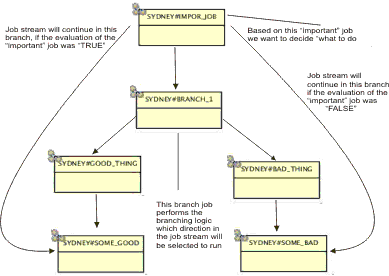Introduction
Define a generic branch job to evaluate a particular job status or output and, based on the specified conditions, decide which jobs to run within the job stream.
HCL Workload Automation offers reporting capabilities, event driven scheduling, and many other features. However, some tasks can be performed only with additional programming, such as the logical evaluation of a process flow within a job stream.
Use a generic branch job to evaluate a particular job status or output and decide which jobs to run within a job stream. The conditions that determine which jobs are run can be very simple (for example, the predecessor ended with the SUCC or ABEND state) or result from a complex Boolean or arithmetical operation.
Figure 1 shows the essential concepts of a generic branch job.

The generic branch job function is not included in HCL Workload Automation, but was developed by HCL specialists during various customer HCL Workload Automation implementations. The generic branch job uses the open interface of HCL Workload Automation.
You can implement simple branching, based on predecessor job status (SUCC or ABEND), in a very short time. However, for more complex scenarios, for example searching for a pattern and making numeric comparisons, you must specify some input parameters.